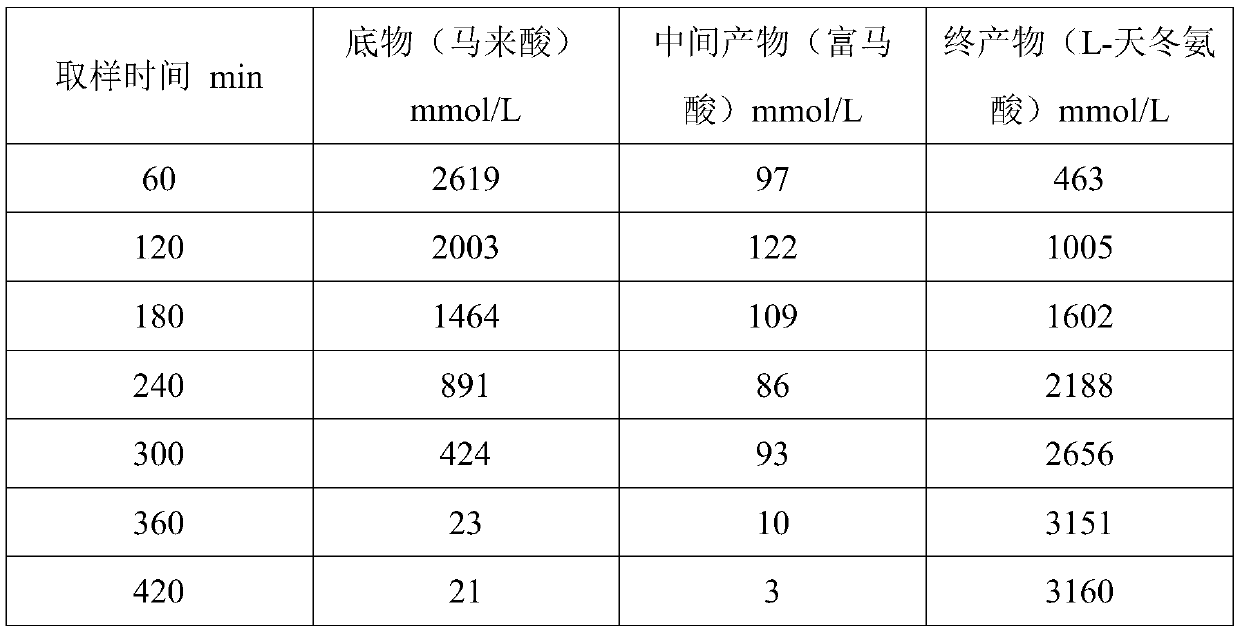Strain for maleic acid whole-cell catalysis synthesis of L-aspartic acid and method
A technology of aspartic acid and maleic acid is applied in the fields of genetic engineering and fermentation engineering to achieve the effects of low price, significant economic and social benefits, and abundant resources
- Summary
- Abstract
- Description
- Claims
- Application Information
AI Technical Summary
Problems solved by technology
Method used
Image
Examples
Embodiment 1
[0042] This example illustrates the method of constructing target plasmids pTarget T2-1, pTarget T2-2, pTarget T2-3, pTarget T2-4 containing gene targeting sequences and homologous recombination fragments by overlapping PCR technology.
[0043] 1. Using the nucleotide sequences shown in SEQ ID NO: 8 and SEQ ID NO: 9 as primers and plasmid pTarget F as a template, linear fragment 1 was obtained by PCR amplification;
[0044] 2. Using the nucleotide sequence shown in SEQ ID NO:8 and SEQ ID NO:10 as a primer, repeat step 1 to obtain linear fragment 2; use the nucleotide sequence shown in SEQ ID NO:8 and SEQ ID NO:11 The sequence is a primer, and step 1 is repeated to obtain linear fragment 3; the nucleotide sequences shown in SEQ ID NO:8 and SEQ ID NO:12 are used as primers, and step 1 is repeated to obtain linear fragment 4
[0045] 3. The linear fragment 1 was digested with SpeI and ligated, and the ligated product was transformed into a competent medium, and the LB plate coate...
Embodiment 2
[0054] This example illustrates the method of using arabinose to induce the preparation of a competent protein containing cas9, and the specific steps include:
[0055] 1. Introduce the pCas plasmid into the Escherichia coli recombinant bacteria to be gene-edited. This biological material is disclosed in the patent literature of the Chinese patent (application number 201811346790.3, application date 2018.11.13), and its preservation number is CCTCC NO: M2018521. Positive recombinants were screened out on the LB plate of mycin;
[0056] 2. Induce the positive recombinants in the above steps with 30 mM arabinose, shake the bacteria for 3-4 hours in an environment of 30° C., the OD value is about 0.4-0.6, and prepare as competent.
Embodiment 3
[0058] This example illustrates the process of knocking out the fumarase-encoding gene fumABC, the citrate synthase-encoding gene gltA, and the argininosuccinate synthase-encoding gene argG of the parental Escherichia coli using CRISPR / Cas9 technology.
[0059] 1. Introduce the pTarget T2-1 plasmid into competent cells containing cas9 protein, and select positive recombinants with LB plates added with spectinomycin and kanamycin;
[0060] 2. Identify the above-mentioned positive recombinants by PCR, and screen out the target strains;
[0061] 3. Transfer the strain 1 screened out in step 2 into the LB culture medium containing kanamycin induced by IPTG, and then transfer to the LB medium plate containing kanamycin and simultaneously containing kanamycin Mycin and spectinomycin on the LB medium plate, screen out the recombinant strain 1 that has degraded the pTarget T2-1 plasmid.
[0062] 4. Inducing the recombinant strains screened in step 3 with arabinose to prepare competen...
PUM
 Login to View More
Login to View More Abstract
Description
Claims
Application Information
 Login to View More
Login to View More - R&D
- Intellectual Property
- Life Sciences
- Materials
- Tech Scout
- Unparalleled Data Quality
- Higher Quality Content
- 60% Fewer Hallucinations
Browse by: Latest US Patents, China's latest patents, Technical Efficacy Thesaurus, Application Domain, Technology Topic, Popular Technical Reports.
© 2025 PatSnap. All rights reserved.Legal|Privacy policy|Modern Slavery Act Transparency Statement|Sitemap|About US| Contact US: help@patsnap.com

